
 |
 |
 |
 |
 |
 |
 |
 |
The Wider World
Under the rule of the Ptolemies, the Greek-speaking Macedonian dynasty that governed Egypt during the final three centuries BCE, Egypt participated intensively in the political and economic life of the Mediterranean. During this time, Egypt also changed demographically and culturally: the Greek population swelled, and Greek language and religion began to be mixed with ancient Egyptian traditions. Then, under Roman rule during the first centuries CE, Egypt became part of an immense, culturally diverse empire, which occupied lands around the Mediterranean. The empire was bound together by Roman traditions, law, government, the military, and the economy (including an empire-wide system of taxation and long-distance trade of a variety of commodities). During the course of the fourth century, the majority--but by no means all--of the population of the Roman empire converted to Christianity. The first Christian Roman emperor, Constantine, moved the capital from Rome to Byzantium, which was renamed Constantinople. Ultimately, the Roman empire came to be known as the Byzantine empire, and Egypt remained a part of this empire until well into the seventh century.
Map of the
Mediterranean, Europe, and Near East
Cities and long-distance trade during the Byzantine period
A Multicultural Society
Egypt after the pharaohs was not exclusively Egyptian ethnically, culturally, or politically. Nor was it predominantly Greek during the Ptolemaic period or Roman during the Roman period. There were many interactions among these populations and, as a consequence, their cultural traditions. The Egyptian language, for example, came to be written in Greek letters, with a few extra letters for sounds not in Greek. This last phase of the ancient Egyptian language is called Coptic. The Egyptian form of Christianity that developed during the Byzantine period is called Coptic Christianity. Many Roman- period and later artifacts are called Coptic as well, although they may reflect other ethnic affiliations or religious traditions.
